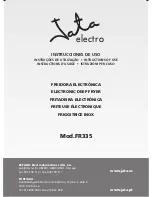
4
2.4 AIR SUPPLY & VENTILATION
The area around the appliance must be kept
clear to avoid obstruction to the flow of
combustion and ventilation air as well as for
ease of maintenance and service. Under no
conditions is the interior of the fryer's cabinet to
be used for storage.
A.
Means must be provided for any
commercial, heavy-duty cooking
appliance to exhaust combustion wastes
to the outside of the building. It is
essential that a deep fat fryer be set
under a powered exhaust hood or that an
exhaust fan be provided in the wall
above the unit, as exhaust gas
temperatures are in the vicinity of 450-
500°F.
Strong exhaust fans in this hood or in the
overall air conditioning system can
produce slight air drafts in the room,
which can interfere with pilot or burner
performance. Air movement should be
checked during installation. If pilot or
burner problems persist, make-up air
openings or baffles may have to be
provided in the room.
B.
Do not place the flue outlet of the fryer
directly into the plenum of the hood, as it
will affect the gas combustion of the
fryer.
C.
Exhaust temperatures, in addition to the
open tank of hot oil, make the storage of
anything on shelving over or behind the
fryer unsafe.
D.
Filters and drip troughs should be part of
any industrial hood, but consult local
codes before hood construction and
installation.
3. RECEIVING & INSTALLING THE
FRYER
3.1 UNPACKING
Check that the container is upright. Use
outward prying -
no hammering
- to remove the
carton. Check the fryer(s) for visible damage; if
such damage has occurred, do not refuse
shipment. Contact the carrier and file the
appropriate freight claims. Do not contact the
factory, as the responsibility for shipping
damage is between the carrier and end user.
Remove, unwrap, wash, and temporarily set
aside any accessories shipped with the fryer.
These may include:
Basket hanger with baskets
Wire crumb screen
Clean-out rod
Drain pipe extension
Teflon cleaning brush
3.2 LEGS
Legs (or optional casters) should be installed
near where the appliance is to be used, as neither
is secure for long transit. After unpacking, raise
the unit about a foot to permit the legs to be
screwed into their couplings, and lower it gently
to keep any undue strain from the legs and
internal mounting hardware. It is strongly
recommended that a pallet or lift jack be used
rather than tilting.
3.3 POSITIONING
Do not push against any of the edges of the unit
in an attempt to adjust its position. Lift it
slightly and place it where it is to be installed.
Although all metal parts are deburred during
manufacture, accidents could occur if the fryer
(or a line-up) should move suddenly while being
pushed into position by hand. Pushing a unit
(rather than using a lift jack) also increases the
probability of bending the leg spindles or the
internal coupling connectors.







































